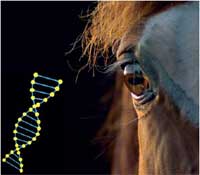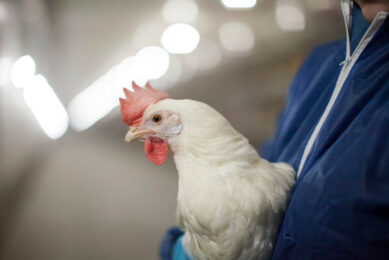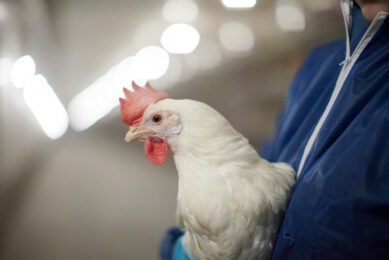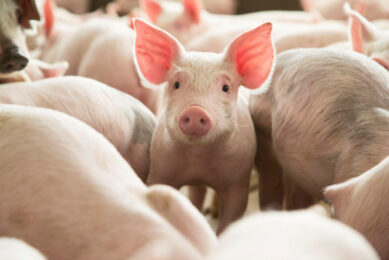Sequencing the horse genome: What does it mean?

Traditional research related to animal nutrition mainly deals with either deficiency or excess of a particular nutrient. But the genomic revolution has propelled the development of several new technologies that can be applied in nutritional sciences. For horses this means we can better measure the bioavailability of various nutrients to find out what works best for the animal.
By Zöe Stevenson, Solutions Deployment Team, Alltech European Bioscience Centre, Dunboyne, Ireland
The publication of the horse genome provides a powerful tool for equine scientists, opening up a wealth of new research areas. With this knowledge, researchers can begin to understand the genetic aspects of equine physiology and disease. Nutrigenomics (Figure 1) is one technology now available to the equine world, whereby the effect of nutrients on gene expression can be studied and the influence on disease or physiology discovered. In other species nutrigenomics is already enabling the optimisation of animal production. It is where nutrition, health and performance coincide, that the animal feed industry should take notice. In this area the potential exists for new product development and promotion to specific customers. Ultimately the Horse Genome project is to benefit the health and welfare of horses. The information gained can be used by horse owners, vets, researchers and nutritionists to improve the health and performance of the animals in their care.
The horse genome project
The horse genome was sequenced in 2007 with the final report published in late 2009. This research enables scientists to better understand the molecular and biological processes responsible for equine health and performance. The genome was sequenced from a Thoroughbred mare called Twilight. The horse industry is worth billions and Thoroughbreds in particular are the lifeblood of horse racing. However, economic importance was not the only reason this breed was chosen, as Thoroughbreds have a very narrow blood line – 81% of an individual’s genes can be traced back to their foundation ancestors. Twilight was chosen to have her genes mapped, as she had the least genetic diversity out of a group of 10 horses originally selected. Besides Twilight, horses from 19 other distinct breeds were chosen to generate a map of genetic variation. Single Nucleotide Polymorphisms (SNiPs) were taken from their genetic code in order to study differences and similarities between the breeds. In turn, genetic differences in disease resistance, physical ability and behavioural characteristics, can be identified. The project is based at the University of Kentucky, USA but is a collaboration of over 100 scientists from 20 countries. They had discovered that the equine genome is made up of 20,322 genes – allowing free access to the data by publishing their work online. Ultimately the aim of the project will be to have a ‘gene chip’ for the horse, as is available for humans and other animal species. Gene chips allow the measurement of gene expression in a particular tissue using messenger RNA labelled on the surface. Thousands of genes can be analysed at once in one experiment, making them a powerful tool for finding new therapies and treatments for diseases.
Areas of current investigation
Before this technology is available researchers are already identifying certain traits in individual horses’ DNA that may predispose them to a particular condition. Already horse owners can use this information to adapt training and nutrition regimens to help prevent or reduce the development of disease. For Thoroughbreds there are several key conditions which affect health and welfare; as well as being of significant economic importance to horse racing. Around the world researchers are investigating the genetic basis of; muscle conditions; developmental bone diseases; contracted-foal syndrome; infertility; fractures; laminitis; infectious diseases and osteoarthritis. At the University of Minnesota scientists are investigating the genetic basis for recurrent exceptional rhabdomylysis (RER) or “tying up”. They have used a SNiP to compare the genetic profiles of horses who regularly ‘tie-up’ with those that never do. The screening process has identified a specific gene linked to an inherited form of RER. This will enable horse owners to know in advance if it is affected and devise a suitable programme of management. At another centre researchers have discovered links between genetic traits, which could be used as markers for certain conditions. Some genes that influence coat colour also have an effect on masts cells, part of the immune system, which in turn are implicated in Laminitis. Potential therapeutic tools to reduce the inflammation caused by this condition could now be evaluated based on gene expression.
Novel therapies for joint problems
The structure and durability of joints is vital for competition horses, just as it is for any human athlete. Owners spend a lot of money on nutritional supplements and various therapies to keep their horse moving. But what if you could find out specifically what would work best for your horse? One area of research using the horse genome has been carried out by scientists at the Gluck Equine Research Centre, where they have taken the first steps to make this possibility a reality. Researchers have established the molecular signature of normal cartilage in an immature horse – which will then enable them to test out novel therapies to help joints to heal. Having established the horse genome, researchers can also make use of genetic tools already created using information from other species. In this way researchers in Texas are suggesting new ways to enhance stallion fertility using RNA profiling of sperm; with the help of microarrays of human cDNA. In the future sperm samples can be screened for reproductive problems and suitable treatment given to those stallions. Scientists from the project are also hoping to use genetic tools to establish the causes of Chronic Obstructive Pulmonary Disease (COPD) – a debilitating condition that affects all horse breeds.
Potential future applications
Sequencing the horse genome is just the prelude. The future will be how to use it for the benefit of the horse. The science of nutrigenomics looks to find out how diet affects gene expression and hence metabolism. It is already known that food components like fats, vitamins or minerals not only provide vital nutrition for the body but also affects the way genes are expressed. As mentioned before, fertility is an important issue in the horse breeding world and selenium, a trace mineral, is known to be essential for fertility. Based on experience from other species this would be a very useful area for equine science to investigate. The hen oviduct is used as a model for reproductive function and using a chicken “gene-chip” Alltech have carried out a number of studies to investigate the effect of selenium source on measures of fertility. They found that organic selenium (Sel-Plex®) up-regulated more genes involved in Follicle Stimulating Hormone (FSH) production than sodium selenite. This explains why, in commercial trials, improved hen fertility is seen when birds are supplemented with this organic selenium.
Knowledge on nutrient impact
So what does this all mean for the animal feed industry? The publication of the equine genome is just the start of the story; researchers around the world are now working on producing specific equine arrays to examine important aspects of physiology. Although various horse genome projects are already ongoing it will be when horse gene-chips are available that the work will get really exciting. Then scientists will be able to evaluate the impact of different nutrients on all aspects of health and performance. This will allow companies to develop dietary regimens ideally suited to horses with a particular health concern or destined to compete at a particular discipline.
That is not to say that the art of horsemanship is dead; training, experience and environment still have a huge role to play. However, if animal feed companies can support those equine professionals with the best nutrition possible, the chance of backing a winner can only increase!
References are available on request.











